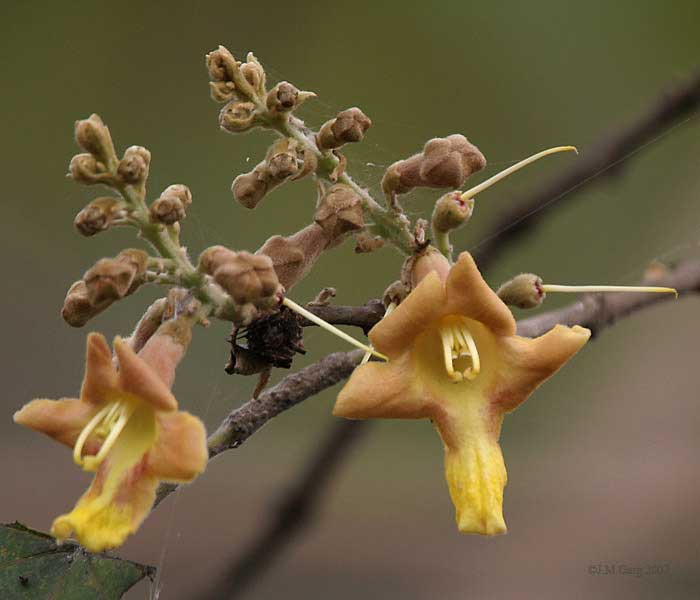
Gmelina arborea (*)
Classification System: APG IV
Superregnum: Eukaryota
Regnum: Plantae
Cladus: Angiosperms
Cladus: Eudicots
Cladus: Core eudicots
Cladus: Asterids
Cladus: Lamiids
Ordo: Lamiales
Familia: Lamiaceae
Subfamilia: Premnoideae
Genus: Gmelina
Species: Gmelina arborea
Name
Gmelina arborea Roxb.
References
Hortus Bengalensis, or a Catalogue of the Plants Growing in the Hounourable East India Company's Botanicl Garden at Calcutta. Serampore 46. 1814
USDA, ARS, National Genetic Resources Program. Germplasm Resources Information Network - (GRIN) [Online Database]. [1]
Vernacular names
অসমীয়া: গমাৰী
বাংলা: গামারি
suomi: Intianjemane
日本語: キダチヨウラク
मराठी: शिवण
မြန်မာဘာသာ: ယမနေ
नेपाली: खमारी, गम्भारी
Gmelina arborea, (in English beechwood, gmelina, goomar teak, Kashmir tree, Malay beechwood, white teak, yamane[3] ), locally known as gamhar, is a fast-growing deciduous tree in the family Lamiaceae.[4]
Distribution and habitat
Fruits
Gmelina arborea grows naturally throughout India, Myanmar, Thailand, Laos, Cambodia, Vietnam and in southern provinces of China. It is found at altitudes from sea level to 1,500 metres (5,000 ft).[1] Since the 1960s, it has been introduced extensively as fast-growing timber trees in Brazil, Gambia, Honduras, Ivory Coast, Malaysia, Malawi, Nigeria, the Philippines, and Sierra Leone. It is also planted in gardens and avenues.[5][6]
Utilization of the species
Bark
Flower
The Lion Throne, the most important, and last surviving, of the eight royal thrones of Myanmar, now in the National Museum in Yangon, is carved from Gmelina arborea wood.[7][8]
Chemistry
Lignans, such as 6" - bromo - isoarboreol, 4-hydroxysesamin, 4,8-dihydroxysesamin, 1,4-dihydroxysesamin (gummadiol), 2-piperonyl-3-hydroxymethyl-4-(α-hydroxy-3,4-methylenedioxybenzyl)-4-hydroxytetrahydrofuran and the 4-O-glucoside of 4-epigummadiol, can be isolated from the heartwood of Gmelina arborea.[9] The parent compounds are arboreol or gmelanone.[10]
Umbelliferone 7-apiosylglucoside can be isolated from the root.[11]
Five constituents, isolated from the heartwood of G. arborea, (+)-7′-O-ethyl arboreol, (+)-paulownin, (+)-gmelinol, (+)-epieudesmin and (−)-β-sitosterol, show antifungal activity against Trametes versicolor.[12]
References
de Kok, R. (2019). "Gmelina arborea". IUCN Red List of Threatened Species. 2019: e.T32354A67741197. doi:10.2305/IUCN.UK.2019-2.RLTS.T32354A67741197.en. Retrieved 19 November 2021.
"Gmelina arborea Roxb". The Plant List. Retrieved 6 March 2020.
"A tree species reference and selection guide". Archived from the original on 2011-09-30. Retrieved 2009-06-28.
"Gmelina arborea Gmelina, Snapdragon, White Teak PFAF Plant Database". pfaf.org. Retrieved 9 February 2021.
Lauridesen, E.B.; Kjaer, E.D. (2002). "Provenance research in Gmelina arborea Linn., Roxb. A summary of results from three decades of research and a discussion of how to use them". The International Forestry Review. 4 (1): 20–29. JSTOR 43740942.
Duke, James A. (1983). Handbook of Energy Crops. Center for New Crops & Plants Products, Purdue University.
"Archived copy". Archived from the original on 2017-04-03. Retrieved 2017-07-23.
Gangadharan V. (2012 Mar 26) Materials behind the method The New Indian Express, page 2
Novel hydroxy lignans from the heartwood of gmelina arborea. A.S.R. Anjaneyulu, A.Madhusudhana rao, V.Kameswara Rao and L.Ramachandra Row, Tetrahedron, 1977, Volume 33, Issue 1, Pages 133–143, doi:10.1016/0040-4020(77)80444-4
The structures of lignans from Gmelina arborea Linn. A.S.R. Anjaneyulu, K.Jaganmohan Rao, V.Kameswara Rao, L.Ramachandra Row, C. Subrahmanyam, A. Pelter, R.S. Ward, Tetrahedron, 1975, Volume 31, Issue 10, Pages 1277–1285, doi:10.1016/0040-4020(75)80169-4
An apiose-containing coumarin glycoside from gmelina arborea root. P. Satyanarayana, P. Subrahmanyam, R. Kasai and O. Tanaka, Phytochemistry, 1985, Volume 24, Issue 8, Pages 1862–1863, doi:10.1016/S0031-9422(00)82575-3
Antifungal activity of constituents from the heartwood of Gmelina arborea: Part 1. Sensitive antifungal assay against Basidiomycetes. F. Kawamura, S. Ohara and A. Nishida, Holzforschung, June 2005, Volume 58, Issue 2, Pages 189–192, doi:10.1515/HF.2004.028
GAMHAR (Gmelina arborea): Indian Council of Forestry Research and Education, Dehradun
Crop index at the Purdue University
Retrieved from "http://en.wikipedia.org/"
All text is available under the terms of the GNU Free Documentation License

